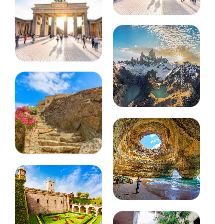The 15 must-dos in the Luberon
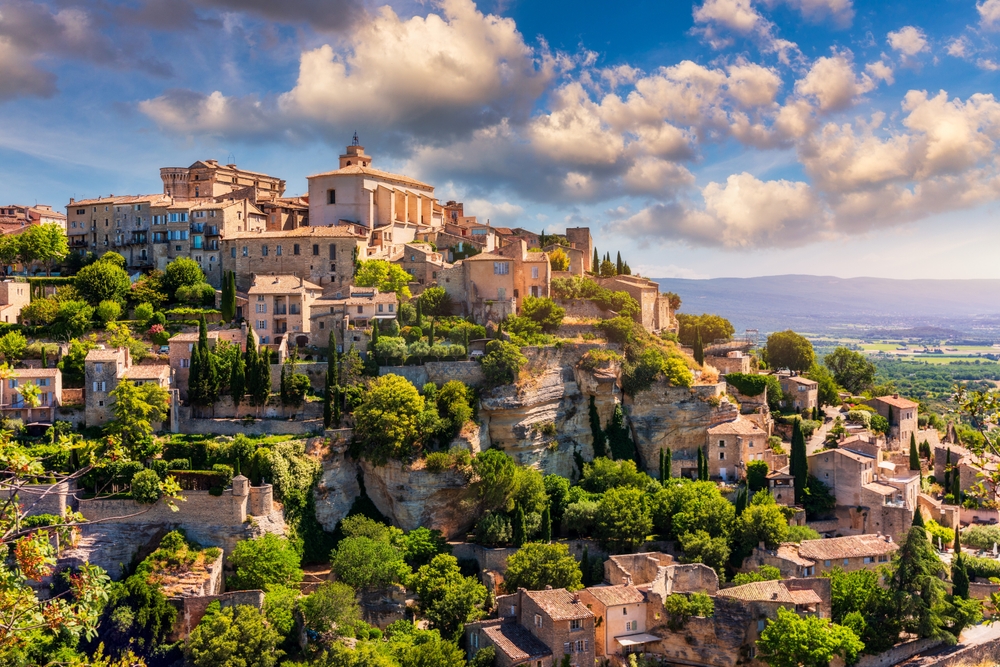
Situated in the heart of Provence, the Luberon fascinates visitors with its breathtaking landscapes, perched villages with golden facades and endless stretches of lavender. This emblematic region of the Vaucluse and Alpes-de-Haute-Provence offers a concentrate of Provençal authenticity, where each village tells its own age-old story. From the flamboyant ochre of Roussillon to the cobbled streets of Gordes, via the mysterious quarries of the Colorado Provençal, the Luberon reveals its treasures to visitors in search of an escape. Whether you’re a lover of the Provençal way of life, a history buff or simply in search of natural beauty, this land of contrasts is sure to seduce you with its wealth of culture and heritage.
200 audioguided tours for cities all around the world
DownloadSee also the Avignon guide:
- The most beautiful villages around Avignon | Complete guide
- Top 5 things to do in Avignon
- Plus Beaux Villages France: 15 listed villages to visit
1. Gordes, the suspended jewel of the Luberon
Perched on a rocky spur facing the Luberon massif, Gordes is the quintessential Provencal village. Listed as one of the Most Beautiful Villages in France, this architectural gem boasts dry-stone houses that seem to grow out of the rock itself. Its winding streets wind between golden facades, offering breathtaking views of the Calavon valley and the Vaucluse mountains at every turn.
The Renaissance château sits atop the village, dominating a maze of vaulted passages and staircases on the hillside. The church of Saint-Firmin, built in the 18th century, completes this harmonious ensemble that has inspired many artists. Don’t miss a visit to the village of Les Bories, a unique example of Provençal rural architecture with its dry-stone huts.
Download the audio tour to discover Avignon on foot and on your own
Extend your discovery of the Luberon by exploring Avignon, the city of the Popes at the gateway to this emblematic region. The Navaway itinerary guides you through 27 points of interest for a complete immersion in Provençal history, the perfect complement to your exploration of the villages of the Luberon.
2. Sénanque Abbey and its lavender fields
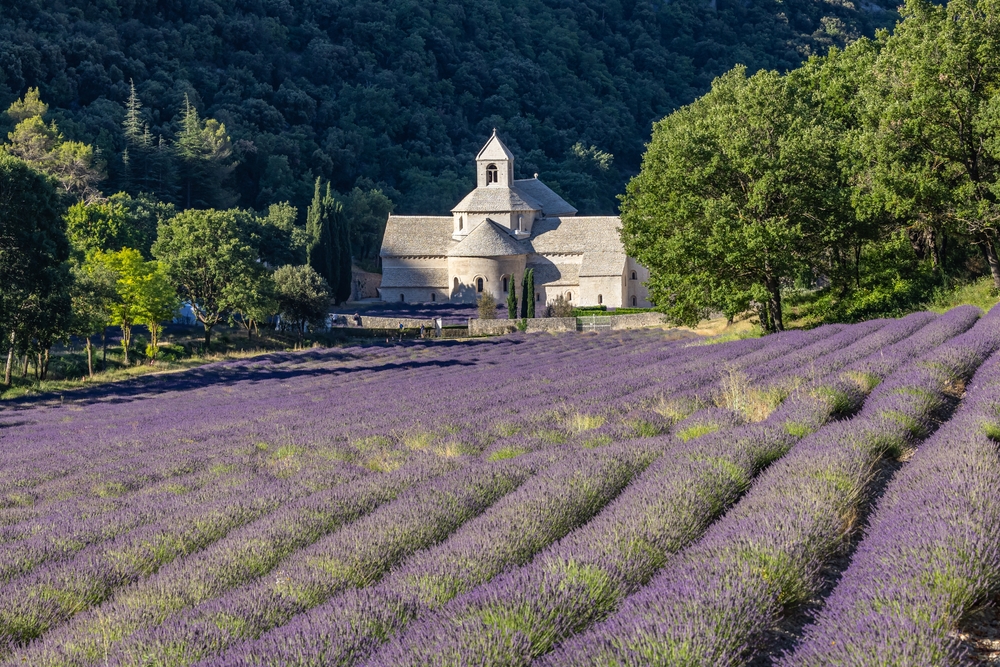
Nestling in a secret valley just a few kilometres from Gordes, the Abbey of Notre-Dame de Sénanque is one of the jewels of Provençal Romanesque art. Founded in 1148 by Cistercian monks, this architectural marvel stands majestically in the heart of lavender fields, which set the landscape ablaze with their violet hues from June to July.
The abbey can be visited all year round, and reveals the rigour of Cistercian architecture: clean lines, broken barrel vaults and deliberate pared-back simplicity. The monks still live here according to the rule of Saint Benedict, perpetuating almost nine centuries of monastic tradition. The shop sells honey, lavender and local products made by the community. The harmony between this architectural masterpiece and its natural setting creates one of the most emblematic images of Provence.
3. Roussillon and its flamboyant ochre
Roussillon blazes with every shade of ochre, from golden yellow to vermilion red. This unique village, also listed as one of the Most Beautiful Villages in France, owes its extraordinary colours to the ochre deposits that surround it. Each façade tells the geological story of the region through a dazzling palette of colours.
The Sentier des Ocres is a magical walk through the heart of the old quarries. There are two routes (30 or 60 minutes) through landscapes sculpted by man and time. Price: €3.50 per adult, free for children under 10. Open all year round except January, this unique site reveals ochre cliffs, fairy chimneys and exceptional geological formations in a setting worthy of an American nature park.
4. The Colorado Provençal in Rustrel
The Colorado Provençal at Rustrel is a spectacular sight in the former open-cast ochre quarries. These landscapes, shaped by industrial quarrying, now offer a backdrop worthy of the American West, with their multi-coloured canyons, rocky spires and natural cirques.
There are several signposted trails to explore this listed site: the Cheminées de Fées trail (2 hours), the Belvedere trail (1 hour) and the themed trails. Rates for self-guided tours: €8 per car, €12 for camper vans. The site is open from February to November. Guided tours add to the experience with explanations of the geology, fauna and flora of this unique environment.
5. Ménerbes, Peter Mayle’s home village
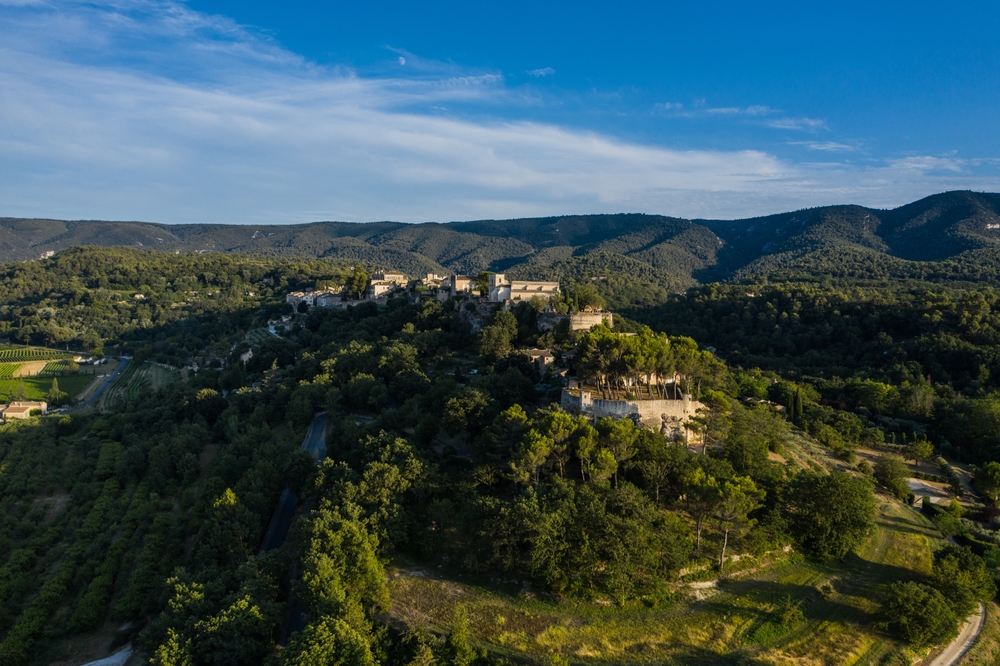
Ménerbes stretches elegantly along its limestone ridge, overlooking vineyards and lavender fields. This third most beautiful village in France’s Luberon region gained worldwide renown thanks to Peter Mayle and his book “A Year in Provence”. The village boasts a remarkable architectural heritage, with its Renaissance houses, 16th-century belfry and partially preserved ramparts.
The Maison de la Truffe et du Vin (Truffle and Wine House) offers an introduction to the local gastronomic treasures. Ménerbes also offers superb views over the Calavon valley and the northern slopes of the Luberon. The cobbled streets invite you to stroll between art galleries, craft shops and shady terraces where you can savour the Provençal art of living.
6. Bonnieux and its panoramic terraces
Bonnieux, with its ochre-coloured houses and terraced gardens, stands on the slopes of the Luberon. This fortified village has preserved the remains of its medieval ramparts and offers one of the finest panoramic views of the Apt valley and surrounding villages. The new church, perched on the summit, rewards the climb with a 360° view of the massif.
The Bakery Museum traces the history of bread in Provence, while the many galleries bear witness to the vitality of the local arts. The Friday morning market brings the village squares alive with the flavours and scents of the local produce. Hiking trails lead directly from the village to the Mourre Nègre and the Cedar forest.
7. Lacoste and the château of the Marquis de Sade
Lacoste proudly stands atop a rocky outcrop with the ruins of its castle. This medieval fortress, remodelled during the Renaissance, was the home of the famous Marquis de Sade from 1769 to 1772. Now owned by Pierre Cardin, the renovated château hosts festivals and contemporary art exhibitions in an exceptional historic setting.
The village unfolds its cobbled streets and dry-stone houses in an authentic Provencal setting. The École Supérieure d’Art has taken up residence in a number of historic buildings, providing a permanent cultural hub. From the heights of the château, you can see all the way from the Petit Luberon to the Grand Luberon.
8. Lourmarin, the pearl of the South Luberon
Lourmarin’s charm lies in its gentle way of life and its perfectly preserved Renaissance château. The only Renaissance château in Provence open to the public, it houses period furniture, tapestries and works of art in a remarkable architectural setting. The village has attracted many artists and writers, from Albert Camus to Henri Bosco.
The narrow shopping streets come alive around the central fountain, creating a unique, friendly atmosphere. The Friday morning market transforms the village into a veritable Provencal theatre. The terraces of cafés and restaurants invite you to savour the local gastronomy under the hundred-year-old plane trees.
9. Ansouis, a preserved medieval fortress
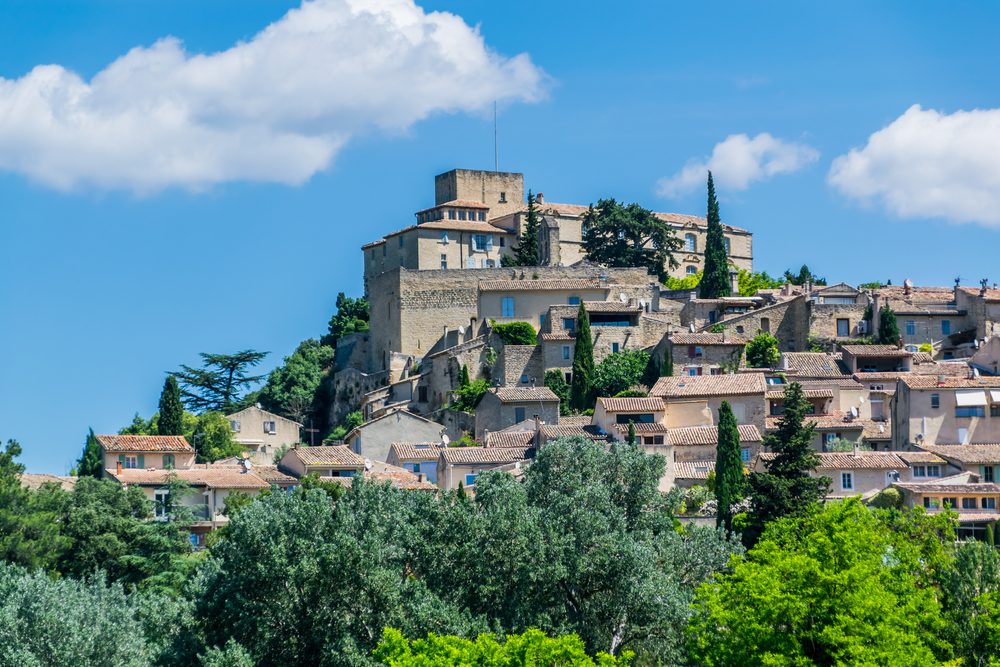
Ansouis unfolds its houses tightly around its imposing fortified castle, an exceptional example of medieval military architecture. Listed as a Historic Monument, the castle is open to visitors, with its furnished flats, formal gardens and terraces overlooking the Durance valley.
This fourth Most Beautiful Village in France in the Luberon has kept its medieval character intact, with vaulted passageways, stone staircases and shady squares. The church of Sainte-Marie houses a remarkable 16th-century altarpiece. The château’s gardens are a haven of freshness, with trimmed box trees and fountains.
10. L’Isle-sur-la-Sorgue, the Venice of Provence
L’Isle-sur-la-Sorgue deserves its nickname of “Venice of Provence”, with its canals winding between the houses and its historic paddlewheels. This water-based town, unique in Provence, developed thanks to the textile industry, powered by the Sorgue.
Europe’s capital of antique dealers, the city boasts more than 300 merchants in vast converted warehouses. The Sunday market turns the streets into a veritable Ali Baba’s cave of antique furniture, objets d’art and curiosities. The collegiate church of Notre-Dame-des-Anges houses a sumptuous Baroque décor, a little-known gem of Provençal religious art.
11. Fontaine-de-Vaucluse and the mysterious resurgence
Fontaine-de-Vaucluse owes its fame to one of the most powerful springs in Europe. This mysterious spring, which gushes out at the foot of a 230-metre-high cliff, feeds the Sorgue and has fascinated visitors since ancient times. Its flow can vary from a few cubic metres to over 100 cubic metres per second, depending on the season.
The village also evokes the memory of Pétrarque, who composed his most beautiful poems dedicated to Laure. The château of the Bishops of Cavaillon dominates the site, while several museums retrace local history: the Musée d’Histoire, the Musée du Santon and the Musée de la Résistance. The walk to the spring offers an enchanting backdrop of plane trees and crystal-clear water.
12. Les Mines de Bruoux, an underground journey
The Mines de Bruoux in Gargas offer a unique underground spectacle in a maze of galleries dug out by man. These former ochre quarries reveal the industrial history of the Luberon through 40 kilometres of galleries on several levels. The guided tour reveals the extraction techniques and working conditions of the miners.
The constant temperature of 12°C provides welcome coolness in summer. The play of light reveals the natural beauty of these underground cathedrals with their colourful vaults. Open from March to November, one-hour guided tour, adult admission €8. The galleries are also home to a large colony of bats, protected in this unique ecosystem.
13. Oppède-le-Vieux, Renaissance village
Oppède-le-Vieux embodies the rebirth of an abandoned village. Deserted after the Second World War, this hilltop hamlet has been restored by enthusiasts of Provençal architecture. Its romantic ruins and restored houses create a unique atmosphere between past and present.
The remains of the castle and the church of Notre-Dame d’Alidon dominate a magnificent landscape overlooking the Comtat plain and Mont Ventoux. The restanques and terraced gardens bear witness to the ancestral toil of the local people. This unspoilt site offers many hiking trails to the crests of the Petit Luberon.
14. The Mourre Nègre, roof of the Luberon
The Mourre Nègre rises to 1,125 metres and is the highest point in the Grand Luberon. This hike, accessible from Auribeau or the Cedar Forest, rewards the effort with an exceptional 360° panorama. On a clear day, the view stretches from the Alps to the Mediterranean, from Mont Ventoux to the Alpilles.
The trail crosses the Cedar forest, a remnant of 19th-century reforestation, creating a landscape worthy of Lebanon. The climb (3 hours round trip) reveals the diversity of the Luberon’s natural environments: garrigue, oak grove, cedar grove and high-altitude grasslands. There’s an orientation table at the summit to help you identify the surrounding massifs.
15. Apt, capital of candied fruit and gateway to the Luberon
Apt, sub-prefecture of the Vaucluse, is the historic capital of the Luberon. This bustling town boasts a remarkable heritage, with Sainte-Anne Cathedral, home to the relics of Saint Anne, and a historic centre with narrow shopping streets. The Saturday morning market is one of the finest in Provence.
Apt specialises in confectionery and candied fruit, a tradition dating back to the Middle Ages. Several confectioners perpetuate this ancestral know-how and offer tastings and tours. The Maison du Parc naturel régional du Luberon presents the natural and cultural riches of the region. Apt is the perfect base from which to explore the entire massif, offering all the services of a modern town in an authentic Provencal setting.
In conclusion, the Luberon reveals its treasures to patient visitors who take the time to discover it. This emblematic region of Provence offers a remarkable diversity of architectural heritage, exceptional natural landscapes and the Mediterranean art of living. Each village tells its own age-old story, each path reveals breathtaking panoramas, and each encounter enriches the traveller’s soul. For a complete exploration of this magical region, don’t hesitate to let yourself be guided by theNavaway d’Avignon itinerary, a privileged gateway to these Provençal wonders that continue to fascinate the whole world.
Frequently asked questions
When is the best time to visit the Luberon?
The best period is from April to October. The lavender blooms from mid-June to mid-July, offering the most emblematic landscapes. Spring and autumn have an ideal climate and are less busy.
How many days does it take to visit the Luberon?
A minimum of 4-5 days will allow you to discover the must-sees. A full week offers a more leisurely pace for savouring the Provençal art of living and exploring the hiking trails.
Where to stay in the Luberon?
Apt is an excellent base with its shops and services. For more charm, choose Gordes, Roussillon or Lourmarin. L’Isle-sur-la-Sorgue offers a good compromise between authenticity and convenience.
Is the Luberon accessible by public transport?
A car is still essential for exploring the region effectively. Some villages are served by bus services from Avignon or Aix-en-Provence, but the timetables are restrictive. Hiring an electric bike is an environmentally-friendly alternative for short distances.
200 audioguided tours for cities all around the world
Download